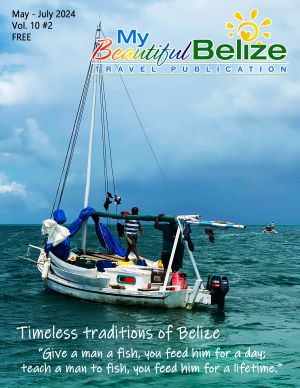Across the globe, there are non-profit organizations that are dedicated to conservation. Powered by selfless individuals who are dedicated to the cause nearest and dearest to their hearts, there are shining stars within the constellation of people who work hard to make a difference in this troubled world. Be it the preservation of endangered flora and fauna, to keeping native languages, cultures, music and the arts alive, each person is an essential cog in the wheel of conservation. Belize is blessed with many such organizations, and although it takes a collective group to accomplish the many challenges before them, often there are those who inspire others to share the same commitment. In this monthly series, we spotlight one of these outstanding individuals.
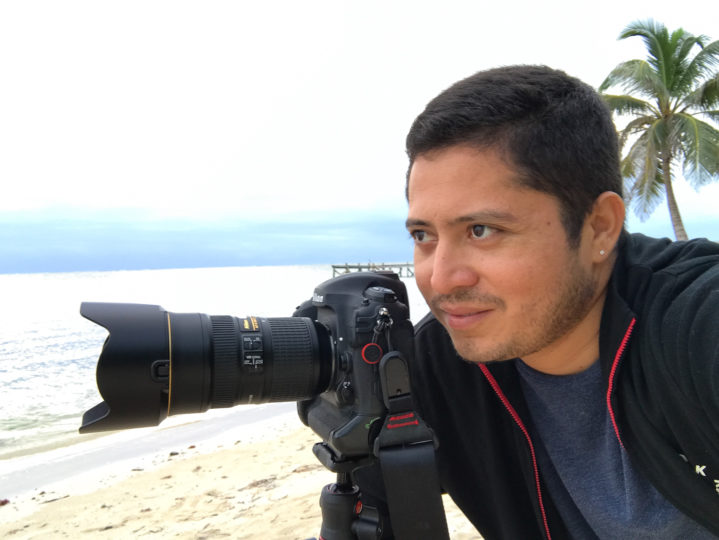 Biodiversity scientist, documentary filmmaker and photographer, sustainable development advocate, conservationist, dive instructor, husband, father and all-around heck-of-a-guy Guadalupe “Valentine” Rosado was born and raised in the Corozal Bay. He grew up wanting to become a medical doctor, got good school grades and especially enjoyed science. His parents had no formal education beyond primary school but were very hard working. “Every day they reminded me of how important it was to study, and they gave me all the positive influence I needed. I worked like a man from an early age (the meat shop, and fish trade business is seriously hard work) and it made me appreciate the importance of studying and pursuing a career. I believe that it made me a stronger person and prepared me to take up tasks without complaining or feeling that I am above what needs to be done,” he recalls.
Biodiversity scientist, documentary filmmaker and photographer, sustainable development advocate, conservationist, dive instructor, husband, father and all-around heck-of-a-guy Guadalupe “Valentine” Rosado was born and raised in the Corozal Bay. He grew up wanting to become a medical doctor, got good school grades and especially enjoyed science. His parents had no formal education beyond primary school but were very hard working. “Every day they reminded me of how important it was to study, and they gave me all the positive influence I needed. I worked like a man from an early age (the meat shop, and fish trade business is seriously hard work) and it made me appreciate the importance of studying and pursuing a career. I believe that it made me a stronger person and prepared me to take up tasks without complaining or feeling that I am above what needs to be done,” he recalls. 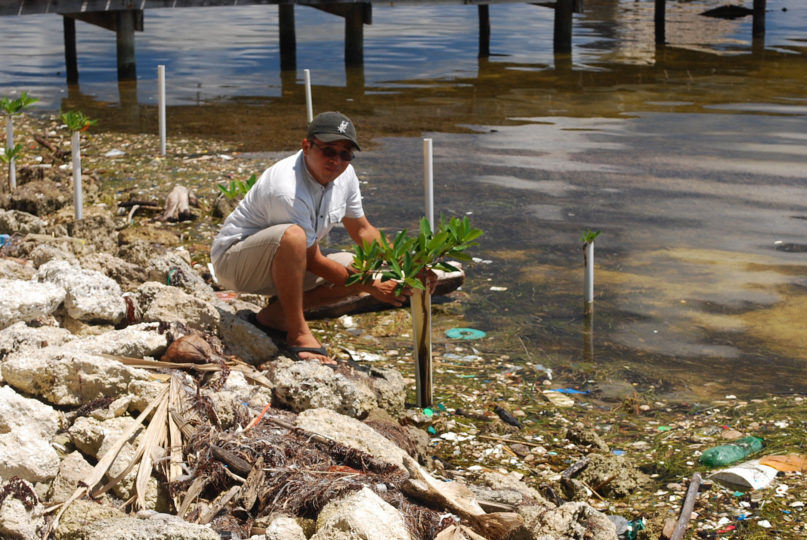 Valentine reflects on his first major ‘life hurdle’ when a few weeks before completing high school and heading off to medical school his ‘intellectual independence’ awoke, revealing that medicine was not a life for him. “I needed to understand what aspect of science I truly wanted to do for the rest of my life. My family and network of support were devastated. They thought I was lost and would only amount to a ‘menial being’ instead of living up to my true potential. My ‘fall back’ was my love for nature and travel and I thought if I pursued biology I would eventually figure out my true passion. I grew up staring at the beautiful Corozal Bay and was always intrigued by the sea. My school holidays were spent in San Pedro visiting family and hanging out at the Amigos del Mar Dive Shop watching the divers come back from dives, hearing their stories and wondering what it was like to explore the reefs. I watched my cousins swim all evening at the end of the dock and could never understand how is it that they learned how to swim on their own? I collected marine brochures and travel magazines and wondered how a boy that cannot swim could ever have a career focused on the sea? Even while I earned my first degree in biology, I wanted to figure out if marine biology would be something I was good at, or if there was something else that would truly fulfill my life’s ambition.” This ‘calling’ was affirmed after he had the opportunity to join a group of university students from the U.S. for their field experience in Belize. “On this trip, I spent an entire week exploring many coral islands in southern Belize. I slept on the dock of the marine field station looking at the marine life ‘glow’ under millions of stars. It was a place far away from any form of light pollution and everyone was very passionate about nature. I was convinced that I had made the right choice. Medicine was not for me, but nature biology, specifically marine, sure was!”
Valentine reflects on his first major ‘life hurdle’ when a few weeks before completing high school and heading off to medical school his ‘intellectual independence’ awoke, revealing that medicine was not a life for him. “I needed to understand what aspect of science I truly wanted to do for the rest of my life. My family and network of support were devastated. They thought I was lost and would only amount to a ‘menial being’ instead of living up to my true potential. My ‘fall back’ was my love for nature and travel and I thought if I pursued biology I would eventually figure out my true passion. I grew up staring at the beautiful Corozal Bay and was always intrigued by the sea. My school holidays were spent in San Pedro visiting family and hanging out at the Amigos del Mar Dive Shop watching the divers come back from dives, hearing their stories and wondering what it was like to explore the reefs. I watched my cousins swim all evening at the end of the dock and could never understand how is it that they learned how to swim on their own? I collected marine brochures and travel magazines and wondered how a boy that cannot swim could ever have a career focused on the sea? Even while I earned my first degree in biology, I wanted to figure out if marine biology would be something I was good at, or if there was something else that would truly fulfill my life’s ambition.” This ‘calling’ was affirmed after he had the opportunity to join a group of university students from the U.S. for their field experience in Belize. “On this trip, I spent an entire week exploring many coral islands in southern Belize. I slept on the dock of the marine field station looking at the marine life ‘glow’ under millions of stars. It was a place far away from any form of light pollution and everyone was very passionate about nature. I was convinced that I had made the right choice. Medicine was not for me, but nature biology, specifically marine, sure was!”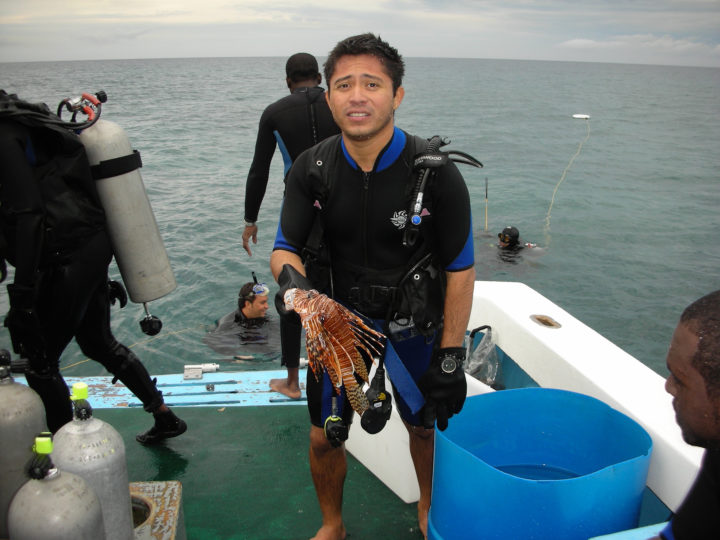
At 17, Valentine finally learned how to swim well enough to take his first diving course. “I worked my butt off for my first summer holiday (as a medical school ‘deserter’) and saved my money to self-finance my scuba course in San Pedro. This is something that I am very proud of. My first dive was a disaster (I got incredibly seasick) and I thought I was done, but thanks to my dive instructor (and the pressure of all the money I had paid for the course), I found the courage to return and finish the course. I was so hooked that throughout my studies in biology at Sacred Heart Junior College and the University of Belize, I pursued a parallel career as a marine guide. By the age of 19, I was already a tour guide, a PADI dive instructor, an Emergency First Response  Instructor and a Belize Emergency Response Team paramedic. The best part of being a marine guide/instructor and struggling biologist was the opportunity to dive every atoll in Belize and every region of our barrier reef. I studied sea turtles at nesting sites, groupers at spawning aggregations, fish and corals using scientific methods and met a lot of amazing people. By the time I went back to do my graduate studies, my experience working on a multitude of conservation projects and coastal communities made it so much more impactful. I now have a science degree in Biodiversity and Sustainable Development and my past experiences gave me a whole different perspective to conservation work.” A man of many environmental interests, Valentine believes there are benefits to having a varied focus. “The ability to actively take in the experience and knowledge from multi-disciplinary realms allows you to make better connections across learning barriers and to develop a unique worldview to solve challenges. I’ve worked in the NGO sector and struggled to understand challenges we had working with the government sector. I spent time working in the government sector and developed a great sense of appreciation for the work that they do and the challenges they face. I spent time working in the private sector and they too have a unique view of the world. I have not mastered these realms, but I have amassed a comprehensive understanding that will enable us to be more effective at our conservation work. Most importantly, biodiversity scientists must be able and willing to work with all sectors to develop solutions to the problems affecting our world, solutions that are based on sound science and the principles of sustainable development.”
Instructor and a Belize Emergency Response Team paramedic. The best part of being a marine guide/instructor and struggling biologist was the opportunity to dive every atoll in Belize and every region of our barrier reef. I studied sea turtles at nesting sites, groupers at spawning aggregations, fish and corals using scientific methods and met a lot of amazing people. By the time I went back to do my graduate studies, my experience working on a multitude of conservation projects and coastal communities made it so much more impactful. I now have a science degree in Biodiversity and Sustainable Development and my past experiences gave me a whole different perspective to conservation work.” A man of many environmental interests, Valentine believes there are benefits to having a varied focus. “The ability to actively take in the experience and knowledge from multi-disciplinary realms allows you to make better connections across learning barriers and to develop a unique worldview to solve challenges. I’ve worked in the NGO sector and struggled to understand challenges we had working with the government sector. I spent time working in the government sector and developed a great sense of appreciation for the work that they do and the challenges they face. I spent time working in the private sector and they too have a unique view of the world. I have not mastered these realms, but I have amassed a comprehensive understanding that will enable us to be more effective at our conservation work. Most importantly, biodiversity scientists must be able and willing to work with all sectors to develop solutions to the problems affecting our world, solutions that are based on sound science and the principles of sustainable development.”
- Miami
- Aruba
- Belize
Over the years he has been involved in several mangrove restoration projects with measured success, not only in Belize but in Costa Rica, Aruba, and Miami, U.S. “In 2013 we reforested three islands in Aruba that had been affected by several storms and were almost completely eroded. Seabirds were still nesting in the sand spit although they didn’t stand a chance against the wave action. The success of the mangroves, despite the conditions, has been a catalyst to expand the project to other areas. In 2015 we assisted a high-profile tourism development in Miami in reforesting their coastline and now that their high-rise towers are almost complete, the project will be expanded to increase the vegetation coverage along the coastline. In Costa Rica, resort owners on the Pacific Coast are now using mangroves to minimize the impacts of erosion. In 2010 we introduced the Riley Encased Methodology (REM) mangroves to San Pedro and several locations in Belize. Our most successful site was in 2014 in San Pedro. It validated our efforts and promised to be an example for coastal developers in Belize. We were inspired that after 2010 the mangroves thrived without additional support and were doing well up to 2014. However, we failed to gain interest in expanding the reforestation project and today none survive. Our lesson is that although our approach was successful, the process must be ongoing, with new mangroves introduced every year and people dedicating their time and investments to safeguard their survival.” 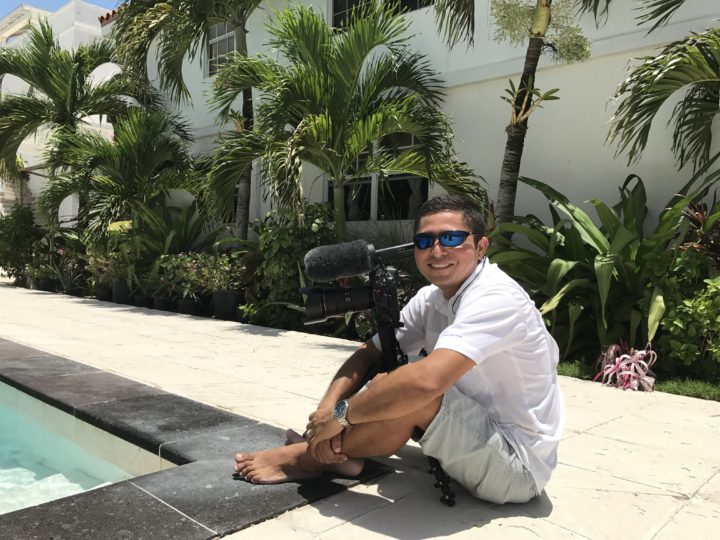 As a talented photographer and filmmaker, Valentine has learned how to incorporate imagery into his conservation work and recently formed a private consulting firm, Grassroots Belize, with his wife Angie. “We combine our qualifications and experience working on conservation projects that instill meaningful change for the environment and the communities that depend on them. We work on conservation projects that we are passionate about and we work with clients who share our core values. My wife has a background in accounting and business administration, and our science work is focused on research and sustainable development planning that aims to strengthen the ability of communities to withstand climatic impacts. We work with NGOs, government, universities and tourism developers on projects that include water quality monitoring, seafloor mapping, and mangrove reforestation, but our work only matters if we can inspire others to participate in projects that aim to improve our world. And, I can now combine my passion for photography and film through images of people living in harmony with nature. We also realize that our philanthropic work with communities helps to meet financing gaps for important conservation projects.
As a talented photographer and filmmaker, Valentine has learned how to incorporate imagery into his conservation work and recently formed a private consulting firm, Grassroots Belize, with his wife Angie. “We combine our qualifications and experience working on conservation projects that instill meaningful change for the environment and the communities that depend on them. We work on conservation projects that we are passionate about and we work with clients who share our core values. My wife has a background in accounting and business administration, and our science work is focused on research and sustainable development planning that aims to strengthen the ability of communities to withstand climatic impacts. We work with NGOs, government, universities and tourism developers on projects that include water quality monitoring, seafloor mapping, and mangrove reforestation, but our work only matters if we can inspire others to participate in projects that aim to improve our world. And, I can now combine my passion for photography and film through images of people living in harmony with nature. We also realize that our philanthropic work with communities helps to meet financing gaps for important conservation projects.  We are in a unique position to foster working partnerships between the private sector and conservation organizations that would not engage in dialogue otherwise. We believe that bridging this link helps the private sector make meaningful contributions to conservation whilst empowering communities. This past year we welcomed our baby girl to this world and it was ever more important to assess our work plan. The stakes are much higher for us now, and it was obvious that we need to reduce our contribution to volunteer work. However, the work that we do helps improve our world. It would not be responsible for me to bring my daughter into a world that is doomed by our actions.” Conservation work certainly comes with its challenges, and Valentine comments, “Belize is such a beautiful place, and this beauty is what attracts tourists and investors, but they are loving Belize to death. We are doing amazing conservation work in Belize but the same beauty that attracts people is being destroyed by development and the global impacts to the environment. I am not an extremist (you know, the tree-hugger stereotype that is associated with biologists and conservationists) and I keep fighting this stereotype. I believe that people and their well-being play an essential role in the work that we do. Preservation is one thing, but globalization has already happened. Conservation, on the other hand, has a strong focus on sustainable development and the role that people play.”
We are in a unique position to foster working partnerships between the private sector and conservation organizations that would not engage in dialogue otherwise. We believe that bridging this link helps the private sector make meaningful contributions to conservation whilst empowering communities. This past year we welcomed our baby girl to this world and it was ever more important to assess our work plan. The stakes are much higher for us now, and it was obvious that we need to reduce our contribution to volunteer work. However, the work that we do helps improve our world. It would not be responsible for me to bring my daughter into a world that is doomed by our actions.” Conservation work certainly comes with its challenges, and Valentine comments, “Belize is such a beautiful place, and this beauty is what attracts tourists and investors, but they are loving Belize to death. We are doing amazing conservation work in Belize but the same beauty that attracts people is being destroyed by development and the global impacts to the environment. I am not an extremist (you know, the tree-hugger stereotype that is associated with biologists and conservationists) and I keep fighting this stereotype. I believe that people and their well-being play an essential role in the work that we do. Preservation is one thing, but globalization has already happened. Conservation, on the other hand, has a strong focus on sustainable development and the role that people play.”
If you would like to keep up with this ever-busy advocate and scientist extraordinaire you can follow Valentine at www.facebook.com/ValentineRosado, www.facebook.com/GrassrootsBelizeFilms or at his website at www.grassrootsbelize.com
- images courtesy Valentine Rosado





